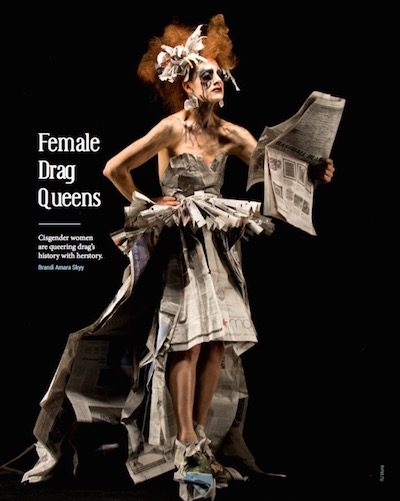Drag is who we are and who we have been for decades.
I was a newly out lesbian when I saw my first drag queen at age sixteen. Her name was Aaron Davis and she was bucking the house down in her big blonde Texas pageant hair, doing backhand springs in six-inch stilettos. I knew right then and there that was what I wanted to do—and I’ve dedicated the last 23 years of my life making my sixteen- year-old dream come true. But I’m just one of the many cis- gender women who have been doing drag longer than RuPaul’s Drag Race fans have been “drag” lovers.
When I was first coming out of the queen closet, I found the term “faux queen” buried in a Wikipedia article about drag queens. I clicked on the link and my world as I knew it blew up; I was home. The first female drag queen to pop up was Fauxnique from San Francisco who made herstory as the first woman to win the Miss Trannyshack Pageant in 2003. I followed her rhinestone bread- crumbs and found other West Coast queens like Bea Dazzler, Holy McGrail, and Trixxie Carr. It was through them that I discovered the term “faux queen” originated in San Francisco and that there was an actual pageant for the kind of drag I did. The Faux Queen Pageant started in 1996 and after a few years’ hiatus was brought back in 2012 by former winner Bea Dazzler, making it the longest running female drag pageant in drag history.
In New York, artists like Carmelita Tropicana were playing with camp and drag aesthetics since the early ’80s. In the ’90s, The World Famous *BOB,* a self-proclaimed female-female impersonator, was living her life both onstage and off as the fabulous queen that she is. And in 2004 in Seattle, The Queen Bees were an all-inclusive performance troupe that performed alongside drag queens. One of their members, Kentucky Fried Woman, would later be one of four women to pen and read the Bio Queen Manifesto—an open letter that addressed conference policy on bio queen performances in king spaces—at the 2001 International Drag King Extravaganza aka IDKE3. It was an herstoric moment and one that proves our fight to be taken seriously as drag performers started long before RuPaul’s 2016 tweet equating what we do to the Miss Universe pageant.
Which is why now, when I hear Willam insinuating that our performances are not drag because we are “real” girls or I read article after article about how we can’t do drag and that we’re appropriating gay male culture, I get pissed.
Because drag isn’t some bandwag- on we are just now jumping on. Drag is who we are and who we have been for decades.
But as much as I want to rally behind all cis-women’s (hell, everybody’s) right to drag, I can’t. Because as a queer woman of color, I am also deeply aware of what drag means to us as a community—and its historical significance in our LGBTQ fight for equality. I know that my gay male brothers have been beaten on the streets and some-times killed because they wanted to wear the clothes that society assigned to me at birth. I understand that drag, like our gay bars, are safe spaces we’ve created for ourselves when the rest of the world condemned us for wanting the right to love who we love. Nor can I deny that within drag I hold a certain amount of privilege because the same social stigmas don’t apply to me when I walk into a department store dressing room with “girl” clothes. So, I get our need to protect the sanctity of drag, I really do.
Because I don’t want drag stripped from our radical queer roots either.
But what I don’t get is us, the rainbow and diverse community we are, perpetuating heteronormative gender norms to police queer women’s access to drag when how we live and express our lives are anything but hetero, normative, or dichotomous. Because while drag may have been birthed in the theater world in the 1800s, that is not the same drag we perform today. Because once we embraced drag as our own, we queered it—meaning we “gayed it up.” In the ’60s, ’70s, and ’80s, drag became a radical act that had nothing to do with gender and everything to do with protesting and subverting a heterosexual culture that wanted to shame us into complacency.
And to say that cis-women, especially lesbians, cannot coexist within this queer reclamation of drag is bullshit—not to mention misogynistic AF. Particularly since women, both gay and straight, have been subverting traditional and socially accepted gender expressions since we unlaced our corsets, unhooked our bustles, ripped off our pantyhose, zipped up our first pair of jeans, and burned our bras.
So while I agree with my gay male counterparts that cis-women per- forming drag (especially straight ones) need to know its historical context, I also believe a lot of gay men and drag queens need to do their due drag diligence, too. Because contrary to popular belief, drag does not stand for dressed as a girl—acronyms didn’t come into general use until the ’60s, centuries after drag became part of our lexicon. It’s folk etymology that’s been touted as fact to police drag’s borders and dictate who and what can be considered a part of it.
But make no mistake, female drag queens are and will forever be a part of drag—and a viable form of it. Because we are the writers of our own herstory—and we’re just getting started.
